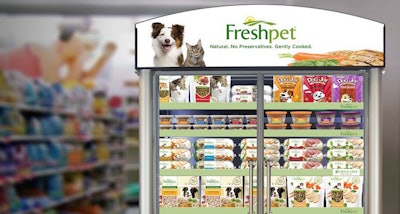
The twin trends ruling the global pet food market, premiumization and humanization, come together in fresh pet food, which often contains ingredients fit for Homo sapiens and packaged like people-food too. Freshpet has latched onto the demand for fresh dog foods and grown to dominate that segment of the pet food market.
Advertising expenditures by Freshpet were a major key to the company’s success, reinforced by Freshpet's proprietary refrigerators, Todd Cunfer, Freshpet CFO, said at the Consumer Analysts Group of New York (CAGNY) conference on Feb. 22 in Boca Raton, Florida, USA.
Five years ago, Freshpet was bought by 4.5 million households in the United States with those customers spending an average US$55.54 per year. That grew 120% to 9.8 million households, each spending US$84.50 per year by January 2023.
Freshpet’s overall dog food market share grew from 2.7% five years ago to 5.8% market share, 115% growth rate. In the fresh pet food segment, the company dominates with a 96% share of the market.
“We build our franchise based on advertising,” Cunfer said. “We've been doing this consistently and increasing our investment in advertising every single year. It is the single biggest driver of our growth.”
Fresh dog food refrigerators as marketing
Since Freshpet products need to be kept cold, retailers must install refrigerators in the pet food aisle to accommodate the products. These machines act as another form of advertising through retail visibility.
“We own those fridges that are in the stores,” he said. “We maintain those fridges it's an expertise and a capability we've honed over many years, but they also provide a brand beacon. Imagine if you will you're in a dark and dusty aisle and the area is a lighted fridge with fresh pet graphics on it. The full brand array is there and it highlights our products' point of differentiation versus everything else in the aisle and inflates our shelf space. It's an enormous advantage but more importantly amplified for advertising.”
Those refrigerators are in more stores each year. Five years ago, 18,004 stores sold Freshpet dog food. By January of this year, 25,281 retailers sold refrigerated dog foods, a growth of 40%.
Retail penetration and challenges to fresh pet food growth
With more stores came more sales. In 2010, Freshpet’s sales were US$16 million. Five years ago overall sales were US$152 million. That figure grew 277% to more than US$575 million by January 2023. Freshpet has had a 35% compound annual growth rate for more than a decade. Company executives estimate that will grow to US$2.7 billion in retail sales, or US$1.8 billion in net sales, with more than 20 million households by 2027.
However, this growth hasn’t necessarily translated into increased profits. Adjusted gross margins have declined from 51.5% in 2017 to 37.1%, primarily caused by quality assurance costs, inflation and plant start-up expenses.
“It's not just about growth anymore,” he said. “It's also about delivering profitability. And we haven't done so well with that. If you take a look at what's happened over the last several years, the clearest picture of that is what's happened to our adjusted gross margin.”
Nevertheless, Cunfer said the company is taking steps to address the three challenges to profitability.


















